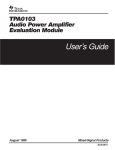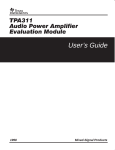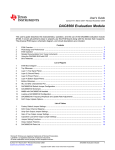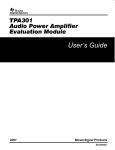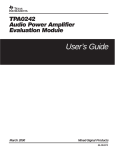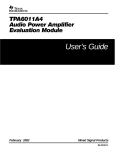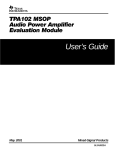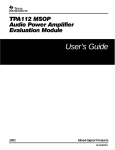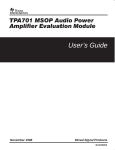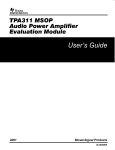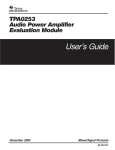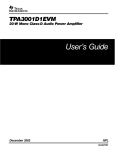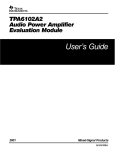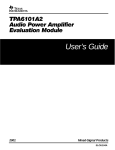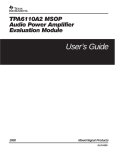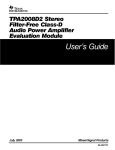Download Texas Instruments TPA0202 User's Manual
Transcript
TPA0202 Audio Power Amplifier Evaluation Module User’s Guide May 1998 Mixed-Signal Products SLOU016 IMPORTANT NOTICE Texas Instruments (TI) reserves the right to make changes to its products or to discontinue any semiconductor product or service without notice, and advises its customers to obtain the latest version of relevant information to verify, before placing orders, that the information being relied on is current. TI warrants performance of its semiconductor products and related software to the specifications applicable at the time of sale in accordance with TI’s standard warranty. Testing and other quality control techniques are utilized to the extent TI deems necessary to support this warranty. Specific testing of all parameters of each device is not necessarily performed, except those mandated by government requirements. Certain applications using semiconductor products may involve potential risks of death, personal injury, or severe property or environmental damage (“Critical Applications”). TI SEMICONDUCTOR PRODUCTS ARE NOT DESIGNED, INTENDED, AUTHORIZED, OR WARRANTED TO BE SUITABLE FOR USE IN LIFE-SUPPORT APPLICATIONS, DEVICES OR SYSTEMS OR OTHER CRITICAL APPLICATIONS. Inclusion of TI products in such applications is understood to be fully at the risk of the customer. Use of TI products in such applications requires the written approval of an appropriate TI officer. Questions concerning potential risk applications should be directed to TI through a local SC sales office. In order to minimize risks associated with the customer’s applications, adequate design and operating safeguards should be provided by the customer to minimize inherent or procedural hazards. TI assumes no liability for applications assistance, customer product design, software performance, or infringement of patents or services described herein. Nor does TI warrant or represent that any license, either express or implied, is granted under any patent right, copyright, mask work right, or other intellectual property right of TI covering or relating to any combination, machine, or process in which such semiconductor products or services might be or are used. Copyright 1998, Texas Instruments Incorporated Preface Related Documentation From Texas Instruments J J TI Plug-N-Play Audio Amplifier Evaluation Platform (literature number SLOU011) provides detailed information on the evaluation platform and its use with TI audio evaluation modules. TPA0202 STEREO 2-W AUDIO POWER AMPLIFIER (literature number SLOS205) This is the data sheet for the TPA0202 audio amplifier integrated circuit. FCC Warning This equipment is intended for use in a laboratory test environment only. It generates, uses, and can radiate radio frequency energy and has not been tested for compliance with the limits of computing devices pursuant to subpart J of part 15 of FCC rules, which are designed to provide reasonable protection against radio frequency interference. Operation of this equipment in other environments may cause interference with radio communications, in which case the user at his own expense will be required to take whatever measures may be required to correct this interference. Trademarks TI is a trademark of Texas Instruments Incorporated. Chapter Title—Attribute Reference iii If You Need Assistance If You Need Assistance. . . If you want to. . . Do this. . . Request more information about Texas Instruments mixed signal products Call the PIC† hotline: (972) 644–5580 Order Texas Instruments documentation Ask questions about product operation or report suspected problems Report mistakes in this document or any other TI documentation Or send a fax to the PIC: (972) 480–7800 Or write to: Texas Instruments Incorporated Product Information Center, MS 3123 P.O. Box 660246 Dallas, Texas 75266 Call the PIC† hotline: (972) 644–5580 Call the PIC† hotline: (972) 644–5580 Send a fax to MSP Marketing Documentation Correction: (972) 480–3160 Or send your comments to: Texas Instruments Incorporated MSP Marketing Documentation, MS 8710 P.O. Box 660199 Dallas, Texas 75266–0199 † Texas Instruments Product Information Center iv Running Title—Attribute Reference Contents 1 Introduction . . . . . . . . . . . . . . . . . . . . . . . . . . . . . . . . . . . . . . . . . . . . . . . . . . . . . . . . . . . . . . . . . . . . . 1.1 Feature Highlights . . . . . . . . . . . . . . . . . . . . . . . . . . . . . . . . . . . . . . . . . . . . . . . . . . . . . . . . . . 1.2 Description . . . . . . . . . . . . . . . . . . . . . . . . . . . . . . . . . . . . . . . . . . . . . . . . . . . . . . . . . . . . . . . . 1.3 TPA0202 EVM Specifications . . . . . . . . . . . . . . . . . . . . . . . . . . . . . . . . . . . . . . . . . . . . . . . . 1-1 1-2 1-3 1-4 2 Quick Start . . . . . . . . . . . . . . . . . . . . . . . . . . . . . . . . . . . . . . . . . . . . . . . . . . . . . . . . . . . . . . . . . . . . . . 2.1 Precautions . . . . . . . . . . . . . . . . . . . . . . . . . . . . . . . . . . . . . . . . . . . . . . . . . . . . . . . . . . . . . . . . 2.2 Quick Start List for Platform . . . . . . . . . . . . . . . . . . . . . . . . . . . . . . . . . . . . . . . . . . . . . . . . . . 2.3 Quick Start List for Stand-Alone . . . . . . . . . . . . . . . . . . . . . . . . . . . . . . . . . . . . . . . . . . . . . . 2-1 2-2 2-3 2-5 3 Details . . . . . . . . . . . . . . . . . . . . . . . . . . . . . . . . . . . . . . . . . . . . . . . . . . . . . . . . . . . . . . . . . . . . . . . . . . 3-1 3.1 Precautions . . . . . . . . . . . . . . . . . . . . . . . . . . . . . . . . . . . . . . . . . . . . . . . . . . . . . . . . . . . . . . . . 3-2 3.2 The TPA0202 Audio Power Amplifier Evaluation Module . . . . . . . . . . . . . . . . . . . . . . . . . 3-3 3.2.1 TPA0202 Audio Amplifier IC . . . . . . . . . . . . . . . . . . . . . . . . . . . . . . . . . . . . . . . . . . 3-4 3.2.2 Depop Circuitry . . . . . . . . . . . . . . . . . . . . . . . . . . . . . . . . . . . . . . . . . . . . . . . . . . . . . 3-5 3.2.3 BTL Operation . . . . . . . . . . . . . . . . . . . . . . . . . . . . . . . . . . . . . . . . . . . . . . . . . . . . . . 3-5 3.2.4 SIngle-Ended Operation . . . . . . . . . . . . . . . . . . . . . . . . . . . . . . . . . . . . . . . . . . . . . . 3-6 3.2.5 Inputs and Gain . . . . . . . . . . . . . . . . . . . . . . . . . . . . . . . . . . . . . . . . . . . . . . . . . . . . . 3-6 3.3 Using The TPA0202 EVM With the Plug-N-Play Evaluation Platform . . . . . . . . . . . . . . . 3-7 3.3.1 Installing and Removing EVM Boards . . . . . . . . . . . . . . . . . . . . . . . . . . . . . . . . . . 3-7 3.3.2 TPA0202 Module Jumper Settings and Switches . . . . . . . . . . . . . . . . . . . . . . . . 3-8 3.3.3 Signal Routing . . . . . . . . . . . . . . . . . . . . . . . . . . . . . . . . . . . . . . . . . . . . . . . . . . . . . 3-11 3.3.4 Mute/Mode . . . . . . . . . . . . . . . . . . . . . . . . . . . . . . . . . . . . . . . . . . . . . . . . . . . . . . . . 3-12 3.3.5 Power Requirements . . . . . . . . . . . . . . . . . . . . . . . . . . . . . . . . . . . . . . . . . . . . . . . . 3-14 3.3.6 Inputs and Outputs . . . . . . . . . . . . . . . . . . . . . . . . . . . . . . . . . . . . . . . . . . . . . . . . . 3-15 3.4 Using The TPA0202 EVM Stand-Alone . . . . . . . . . . . . . . . . . . . . . . . . . . . . . . . . . . . . . . . 3-16 3.4.1 TPA0202 EVM Connected for BTL Output . . . . . . . . . . . . . . . . . . . . . . . . . . . . . 3-16 3.4.2 TPA0202 EVM Connected for Single-Ended Output . . . . . . . . . . . . . . . . . . . . . 3-17 3.5 TPA0202 Audio Power Amplifier Evaluation Module Parts List . . . . . . . . . . . . . . . . . . . 3-18 Chapter Title—Attribute Reference v Running Title—Attribute Reference Figures 1–1 2–1 2–2 2–3 3–1 3–2 3–3 3–4 3–5 3–6 3–7 3–8 3–9 3–10 The TI TPA0202 Audio Amplifier Evaluation Module . . . . . . . . . . . . . . . . . . . . . . . . . . . . . . . 1-3 Quick Start Platform Map . . . . . . . . . . . . . . . . . . . . . . . . . . . . . . . . . . . . . . . . . . . . . . . . . . . . . . 2-2 Module Preparation . . . . . . . . . . . . . . . . . . . . . . . . . . . . . . . . . . . . . . . . . . . . . . . . . . . . . . . . . . . 2-4 Quick Start Module Map . . . . . . . . . . . . . . . . . . . . . . . . . . . . . . . . . . . . . . . . . . . . . . . . . . . . . . . 2-5 The TI Plug-N-Play Audio Amplifier Evaluation Platform . . . . . . . . . . . . . . . . . . . . . . . . . . . . 3-2 TPA0202 EVM . . . . . . . . . . . . . . . . . . . . . . . . . . . . . . . . . . . . . . . . . . . . . . . . . . . . . . . . . . . . . . . . 3-3 TPA0202 EVM Schematic Diagram . . . . . . . . . . . . . . . . . . . . . . . . . . . . . . . . . . . . . . . . . . . . . . 3-4 TPA0202 Amplifier IC . . . . . . . . . . . . . . . . . . . . . . . . . . . . . . . . . . . . . . . . . . . . . . . . . . . . . . . . . . 3-5 TPA0202 EVM Jumpers and Switches . . . . . . . . . . . . . . . . . . . . . . . . . . . . . . . . . . . . . . . . . . . 3-8 Platform Signal Routing and Outputs . . . . . . . . . . . . . . . . . . . . . . . . . . . . . . . . . . . . . . . . . . . 3-11 Mute/Mode and Polarity Control . . . . . . . . . . . . . . . . . . . . . . . . . . . . . . . . . . . . . . . . . . . . . . . . 3-12 Typical Headphone Plug . . . . . . . . . . . . . . . . . . . . . . . . . . . . . . . . . . . . . . . . . . . . . . . . . . . . . . 3-15 TPA0202 EVM Connected for Stereo BTL Output . . . . . . . . . . . . . . . . . . . . . . . . . . . . . . . . 3-16 TPA0202 EVM Connected for Stereo Single-Ended Output . . . . . . . . . . . . . . . . . . . . . . . . 3-17 Tables 2–1 2–2 2–3 2–4 3–1 3–2 3–1 vi Typical TI Plug-N-Play Platform Jumper and Switch Settings for the TPA0202 . . . . . . . . . 2-1 Typical TPA0202 EVM Jumper Settings . . . . . . . . . . . . . . . . . . . . . . . . . . . . . . . . . . . . . . . . . . 2-1 Platform Jumper and Switch Settings for the TPA0202 . . . . . . . . . . . . . . . . . . . . . . . . . . . . . 2-3 Typical TPA0202 EVM Jumper Settings . . . . . . . . . . . . . . . . . . . . . . . . . . . . . . . . . . . . . . . . . . 2-4 Typical TPA0202 EVM Jumper Settings for BTL Stand-Alone . . . . . . . . . . . . . . . . . . . . . . 3-16 Typical TPA0202 EVM Jumper Settings for Single-Ended Stand-Alone . . . . . . . . . . . . . . 3-17 TPA0202 EVM Parts List . . . . . . . . . . . . . . . . . . . . . . . . . . . . . . . . . . . . . . . . . . . . . . . . . . . . . . 3-18 Chapter 1 Introduction This chapter provides an overview of the Texas Instruments (TI) TPA0202 Audio Amplifier Evaluation Module (SLOP202). It includes a list of EVM features, a brief description of the module illustrated with a pictorial diagram, and a list of EVM specifications. Topic Page 1.1 Feature Highlights . . . . . . . . . . . . . . . . . . . . . . . . . . . . . . . . . . . . . . . . . . . . 1–2 1.2 Description . . . . . . . . . . . . . . . . . . . . . . . . . . . . . . . . . . . . . . . . . . . . . . . . . . . 1–3 1.3 TPA0202 EVM Specifications . . . . . . . . . . . . . . . . . . . . . . . . . . . . . . . . . . . 1–4 Introduction 1-1 Feature Highlights 1.1 Feature Highlights The TI TPA0202 Audio Amplifier Evaluation Module and the TI Plug-N-Play Audio Amplifier Evaluation Platform include the following features: - - TPA0202 Stereo 2-W Audio Power Amplifier Evaluation Module J J J J J J J J J J J J - 1-2 Dual channel, bridge-tied load (BTL) or single-ended operation 3.3-V and 5-V operation 2 W per channel output power into 3 Ω at 5 V, BTL 850 mW per channel output power into 3 Ω at 3.3 V, BTL Ultra-low current consumption in shutdown/mute mode (5 µA) Internal input MUX selects among two sets of stereo inputs Module gain adjustable between approximately 2 and 22 Quick and Easy Configuration with The TI Plug-N-Play Audio Amplifier Evaluation Platform J - Internal depop circuitry to eliminate turn-on transients in outputs Evaluation module is designed to simply plug into the platform, automatically making all signal, control, and power connections Platform provides flexible power options Jumpers on the platform select power and module control options Switches on the platform route signals Platform provides quick and easy audio input and output connections Platform Power Options J J J J External 5-V – 15-V DC VCC supply inputs External regulated VDD supply input Socket for on-board 5 V/3.3 V VDD voltage regulator EVM On-board overvoltage and reverse polarity power protection Platform Audio Input and Output Connections J J J J J Left and right RCA phono jack inputs Miniature stereo phone jack input Left and right RCA phono jack outputs Left and right compression speaker terminal outputs Miniature stereo headphone jack output Introduction Description 1.2 Description The TPA0202 Stereo 2-W Audio Power Amplifier Evaluation Module is a complete, 2-Watt per channel stereo audio power amplifier. It consists of the TI TPA0202 Stereo 2-W Audio Power Amplifier IC along with a small number of other parts mounted on a circuit board that measures approximately 2¼ inches by 1½ inches (Figure 1–1). Figure 1–1. The TI TPA0202 Audio Amplifier Evaluation Module RHP C7 GND RIN C6 RVDD R10 R8 S5 S6 S3 C8 R9 GND R7 C9 C10 TPA0202 SAMPLE EVM Lit.# SLOP202 R11 GND + C11 ROUT+ GND ROUT– HP/L* SE/BTL* S4 R12 U1 S8 D1 R13 S7 R2 C3 R4 GND LIN C1 R1 C2 R3 GND LHP C4 C5 S2 MUTE S1 + C12 LVDD GND R5 LOUT– GND LOUT+ Single in-line header pins extend from the underside of the module circuit board to allow the EVM to be plugged into the TI Plug-N-Play Audio Amplifier Evaluation Platform, or to be wired directly into existing circuits and equipment when used stand-alone. The platform has room for a single TPA0202 evaluation module and is a convenient vehicle for demonstrating TI’s audio power amplifier and related evaluation modules. The EVMs simply plug into the platform, which automatically provides power to the modules, interconnects them correctly, and connects them to a versatile array of standard audio input and output jacks and connectors. Easy-to-use configuration controls allow the platform and EVMs to quickly model many possible end-equipment configurations. There is nothing to build, nothing to solder, and nothing but the speakers included with the platform to “hook up.” Introduction 1-3 TPA0202 EVM Specifications 1.3 TPA0202 EVM Specifications Supply voltage range, VDD . . . . . . . . . . . . . . . . . . . . . . . . . . . . . . . . . . . . . . . . . . . . . . . . 3 V to 5.5 V Supply current, IDD . . . . . . . . . . . . . . . . . . . . . . . . . . . . . . . . . . . . . . . . . . . . . . . . . . . . . . . . . . 2 A max Continuous output power per channel, PO: 4-Ω BTL, VDD = 5 V . . . . . . . . . . . . . . . . . . . . . . 2 W 4-Ω BTL, VDD = 3.3 V . . . . . . . . . . . . . . . . 800 mW Audio input voltage, VI: SE . . . . . . . . . . . . . . . . . . . . . . . . . . . . . . . . . . . . . . . . . . . . . . . . 4 Vpp max BTL . . . . . . . . . . . . . . . . . . . . . . . . . . . . . . . . . . . . . . . . . . . 0.75 Vpp max Minimum load impedance, RL . . . . . . . . . . . . . . . . . . . . . . . . . . . . . . . . . . . . . . . . . . . . . . . . . . . . 3 Ω 1-4 Introduction Chapter 2 Quick Start The steps in this chapter can be followed to quickly prepare the TPA0202 audio amplifier EVM for use. Using the TPA0202 with the TI Plug-N-Play Audio Amplifier Evaluation Platform is a quick and easy way to connect power, signal and control inputs, and signal outputs to the EVM using standard connectors. However, the audio amplifier evaluation module can be used stand-alone by making connections directly to the module pins, and can be wired directly into existing circuits or equipment. The platform switch and jumper settings shown in Table 2–1 are typical for the TPA0202 EVM and will cause the TPA0202 to switch to single-ended output mode when a plug is inserted into platform headphone jack J10. Table 2–1. Typical TI Plug-N-Play Platform Jumper and Switch Settings for the TPA0202 EVM JP6 JP7 JP8 S2 S3 P-N-P Platform Mode X Hi Note 2 X Notes: 1) X = Don’t care 2) Set S2 to ON when signal conditioning board is installed in U1; set S2 to OFF when no signal conditioning board is installed. Table 2–2. Typical TPA0202 EVM Jumper Settings EVM S1 S3 S4 S5 S6 S8 TPA0202 ON OFF OFF ON ON OFF Note: S8 should remain OFF at all times. ON = shunt installed OFF = open Topic Page 2.1 Precautions . . . . . . . . . . . . . . . . . . . . . . . . . . . . . . . . . . . . . . . . . . . . . . . . . . 2-2 2.2 Quick Start List for Platform . . . . . . . . . . . . . . . . . . . . . . . . . . . . . . . . . . . 2–3 2.3 Quick Start List for Stand-Alone . . . . . . . . . . . . . . . . . . . . . . . . . . . . . . . . 2–5 Quick Start 2-1 Precautions 2.1 Precautions Power Supply Input Polarity and Maximum Voltage Always ensure that the polarity and voltage of the external power connected to VCC power input connector J1, J2, and/or VDD power input connector J6 are correct. Overvoltage or reverse-polarity power applied to these terminals can open on-board soldered-in fuses and cause other damage to the platform, installed evaluation modules, and/or the power source. Inserting or Removing EVM Boards Do not insert or remove EVM boards with power applied — damage to the EVM board, the platform, or both may result. Figure 2–1. Quick Start Platform Map 1 17 7b C1+ On Off JP3 ICC VR2 JP4 VR1 F2 U6 + LED2 VDD + Right – Out U3 Off S2 J4 Stereo In U2 U1 Audio Input Left Out J5 Left In Left Out Stereo Headphone Output HP Out J10 6 + R4 5 J9 + S3 HP Source GND 2 R3 – Hi Spk(U2-U4) C3 C2 JP8 U5 U5 JP7 HP(U5) U2-U4 Polarity Lo TP1 TEXAS INSTRUMENTS 1997 3 Mode Mute JP6 U4 ****CAUTION**** Do not insert or remove EVM boards with power applied Plug-N-Play Audio Amplifier Evaluation Platform SLOP097 Rev. C.1 Speaker Output 10 + On Conditioning 9 7a J8 J7 Right Out JP5 IDD LED1 VCC Audio Power Amps DC Power In/Out J6 VDD In/Out D1 D2 D3 J3 Right In R2 R1 Signal Conditioning 2-2 POWER B1 SUPPLY S1 Pwr Batt J1 D4 J2 AC/DC In 7b JP2 AC/DC (J2) JP1 VCC(J1) DC SOURCE VCC In + Power Input F1 7b 7b R5 4 Quick Start Quick Start List for Platform 2.2 Quick Start List for Platform Follow these steps when using the TPA0202 EVM with the TI Plug-N-Play Audio Amplifier Evaluation Platform (see the platform user’s guide, SLOU011, for additional details). Numbered callouts for selected steps are shown in Figure 2–1 and Figure 2–2, and details appear in Chapter 3. - Platform preparations 1) Ensure that all external power sources are set to OFF and that the platform power switch S1 is set to OFF. 2) Install a TPA0202 module in platform socket U2, taking care to align the module pins correctly. 3) Use switch S2 to select or bypass the signal conditioning EVM (U1). 4) Set control signal Polarity jumper JP8 to Hi. 5) Set jumper JP6 to select the Mode control input (causes the TPA0202 to switch to the single-ended output mode if a plug is inserted into platform headphone jack J10). 6) If the headphone Jack (J10) output will be used, set Hp source switch S3 to U2–U4. Table 2–3. Platform Jumper and Switch Settings for the TPA0202 EVM JP6 JP7 JP8 S2 S3 P-N-P Platform Mode X Hi Note 2 X Notes: - 1) X = Don’t care 2) Set S2 to ON when signal conditioning board is installed in U1; set S2 to OFF when no signal conditioning board is installed. Power supply 7) Select and connect the power supply (ensure power supply is set to OFF ): a) Connect an external regulated power supply set to 5 V to platform VDD power input connector J6 taking care to observe marked polarity, or b) Install a voltage regulator EVM (SLVP097 or equiv.) in platform socket U6. Connect a 7 V – 12 V power source to a platform VCC power input J1 or J2 and jumper the appropriate power input (see platform user’s guide). - Inputs and outputs 8) Ensure that the audio signal source level is set to minimum. 9) Connect the audio source to left and right RCA phono jacks J3 and J5 or stereo miniature phone jack J4. 10) Connect 3-Ω – 8-Ω speakers to left and right RCA jacks J7 and J9 or to stripped wire speaker connectors J8. Quick Start 2-3 Quick Start List for Platform - Evaluation Module Preparations Figure 2–2. Module Preparation 14 RHP C7 GND RIN C6 RVDD R10 R8 S5 S6 S3 C8 R9 GND R7 C9 C10 TPA0202 SAMPLE EVM Lit.# SLOP202 16 R11 GND + C11 12 ROUT+ GND ROUT– HP/L* SE/BTL* S4 R12 15 13 U1 S8 D1 R13 S7 R2 C3 R4 GND LIN C1 R1 C2 MUTE S1 GND LHP S2 C4 C5 + C12 LVDD R3 GND R5 11 LOUT– GND LOUT+ 11) To have the module amplifier IC enter the shutdown mode when the module mute control input is activated, set shutdown jumper S1 to ON. To have the amplifier IC only mute when the module mute control input is activated, set shutdown jumper S1 to OFF. 12) To select the line inputs, set input select jumper S3 to OFF. To select the headphone inputs, set input select jumper S3 to ON. 13) To allow the module SE/BTL control input to switch the amplifier IC between single ended (SE) and bridge-tied load (BTL) output modes, set output mode jumper S4 to OFF. To keep the module amplifier IC in the single-ended output mode regardless of the control input state, set jumper S4 to ON. 14) Set VDD bridge jumper S5 to either ON or OFF for normal operation. 15) To automatically select the headphone inputs when the single-ended output mode is selected by the module SE/BTL control input, set autosense control jumper S6 to ON. To isolate the amplifier IC input select pin from the module output mode select control input, set autosense control jumper S6 to OFF. 16) Set junction temperature measurement jumper S8 to OFF for normal operation. Table 2–4. Typical TPA0202 EVM Jumper Settings EVM S1 S3 S4 S5 S6 S8 TPA0202 ON OFF OFF ON ON OFF Note: - S8 should remain open at all times, ON = shunt installed, OFF = open Power Up 17) Verify correct voltage and input polarity and set the external power supply to ON. If VCC and an on-board regulator EVM are used to provide VDD, set platform power switch S1 to ON. Platform LED2 should light indicating the presence of VDD, and the evaluation modules installed on the platform should begin operation. 18) Adjust the signal source level as needed. 2-4 Quick Start Quick Start List for Stand-Alone 2.3 Quick Start List for Stand-Alone Follow these steps to use the TPA0202 EVM stand-alone or when connecting it into existing circuits or equipment. Connections to the TPA0202 module header pins can be made via individual sockets, wire-wrapping, or soldering to the pins, either on the top or the bottom of the module circuit board. Numbered callouts for selected steps are shown in Figure 2–3 and details appear in Chapter 3. Figure 2–3. Quick Start Module Map 9 RHP C7 GND RIN C6 RVDD R10 R8 S5 S6 S3 C8 R9 GND R7 C9 C10 TPA0202 SAMPLE EVM Lit.# SLOP202 11 R11 GND + C11 7 ROUT+ GND ROUT– HP/L* SE/BTL* S4 R12 10 8 U1 S8 D1 R13 S7 R2 C3 R4 GND LIN C1 R1 C2 R3 GND LHP - C4 C5 S2 MUTE S1 + C12 LVDD GND R5 6 LOUT– GND LOUT+ Power supply 1) Ensure that all external power sources are set to OFF. 2) Connect an external regulated power supply set to 5 V to the module VDD and GND pins taking care to observe marked polarity. Separate right channel and left channel VDD supplies can be connected, or a single supply can be used for both. - Inputs and outputs 3) Ensure that audio signal source level adjustments are set to minimum. 4) Connect the audio source to the module RIN/LIN and GND or RHP/LHP and GND pins of each channel taking care to observe marked polarity. 5) Select output mode: a) For BTL output, connect an 3-Ω – 8-Ω speaker to the module OUT+ OUT– pins of each channel, or b) For single-ended output, connect a headphone or an 3-Ω – 8-Ω speaker to the module OUT+ and GND pins of each channel through a 33 µF to 1000 µF output-coupling capacitor (Figure 3–10). Quick Start 2-5 Quick Start List for Stand-Alone - Evaluation Module Preparations 6) To have the module amplifier IC enter the shutdown mode when the module mute control input is activated, set shutdown jumper S1 to ON. To have the amplifier IC only mute when the module mute control input is activated, set shutdown jumper S1 to OFF. 7) To select the line inputs, set input select jumper S3 to OFF. To select the headphone inputs, set input select jumper S3 to ON. 8) To allow the module SE/BTL control input to switch the amplifier IC between single ended (SE) and bridge-tied load (BTL) output modes, set output mode jumper S4 to OFF. To keep the module amplifier IC in the single-ended output mode regardless of the control input state, set jumper S4 to ON. 9) Set VDD bridge jumper S5 to ON to connect the RVDD and LVDD module power input pins together, or to OFF to keep the two power inputs isolated on board 10) To automatically select the headphone inputs when the single-ended output mode is selected by the module SE/BTL control input, set autosense control jumper S6 to ON. To isolate the amplifier IC input select pin from the module output mode select control input, set autosense control jumper S6 to OFF. 11) Set junction temperature measurement jumper S8 to OFF for normal operation - Control Inputs 12) Connect control lines to the various module control input pins as needed: a) HP/L*: A high selects the headphone input pins; a low or float selects the line input pins. b) SE/BTL*: A high selects the single-ended output mode; a low or float selects the bridge-tied load output mode. - c) MUTE: A high mutes the amplifier IC on the module; a low or float allows normal operation. Power-up 13) Verify correct voltage and input polarity and set the external power supply to ON. The EVM should begin operation. 14) Adjust the signal source level as needed. 2-6 Quick Start Chapter 3 Details This chapter provides details on the TPA0202 IC, the evaluation module, and the steps in the Quick-Start List, additional application information, and a parts list for the TPA0202 evaluation module. Topic Page 3.1 Precautions . . . . . . . . . . . . . . . . . . . . . . . . . . . . . . . . . . . . . . . . . . . . . . . . . . 3–2 3.2 The TPA0202 Audio Power Amplifier Evaluation Module . . . . . . . . . 3–3 3.3 Using the TPA0202 EVM With the Plug-N-Play Evaluation Platform . . . . . . . . . . . . . . . . . . . . . . . . . . . . . . . . . . . . . . . . . . . 3–7 3.4 Using The TPA0202 EVM Stand-Alone . . . . . . . . . . . . . . . . . . . . . . . . 3–16 3.5 TPA0202 Audio Power Amplifier Evaluation Module Parts List . . 3–18 Details 3-1 Precautions 3.1 Precautions Power Supply Input Polarity and Maximum Voltage Always ensure that the polarity and voltage of the external power connected to VCC power input connector J1, J2, and/or VDD power input connector J6 are correct. Overvoltage or reverse-polarity power applied to these terminals can open on-board soldered-in fuses and cause other damage to the platform, installed evaluation modules, and/or the power source. Inserting or Removing EVM Boards Do not insert or remove EVM boards with power applied — damage to the EVM board, the platform, or both may result. Figure 3–1. The TI Plug-N-Play Audio Amplifier Evaluation Platform On Off C1+ ICC VR2 JP4 F2 + J6 VDD In/Out + Right – Out U3 Off S2 J4 Stereo In U2 U1 Speaker Output + On Conditioning Left Out J5 Left In – JP6 U4 Mode Mute Stereo Headphone Output HP Out J10 + R4 Left Out + S3 HP Source GND R3 J9 Lo Hi Spk(U2-U4) C3 C2 JP8 U5 U5 JP7 HP(U5) U2-U4 Polarity TP1 TEXAS INSTRUMENTS 1997 Plug-N-Play Audio Amplifier Evaluation Platform SLOP097 Rev. C.1 DC Power In/Out J8 J7 Right Out LED2 VDD Audio Power Amps ****CAUTION**** Do not insert or remove EVM boards with power applied 3-2 U6 JP5 IDD LED1 VCC J3 Right In R2 R1 Signal Conditioning Audio Input POWER B1 D1 D2 D3 D4 J2 AC/DC In SUPPLY S1 Pwr VR1 J1 JP3 Batt JP2 AC/DC (J2) JP1 VCC(J1) DC SOURCE VCC In + Power Input F1 R5 Details The TPA0202 Audio Power Amplifier Evaluation Module 3.2 The TPA0202 Audio Power Amplifier Evaluation Module The TPA0202 Audio Power Amplifier Evaluation Module is powered by a TPA0202 stereo power amplifier capable of delivering greater than 2 W of continuous power per channel into 3-Ω loads. The amplifier IC can be operated in either the BTL or single-ended output mode. The evaluation module includes control inputs for muting and shutdown, selection between two sets of stereo inputs, and switching between single ended and bridge-tied load output modes. The module can be used with the TI Plug-N-Play Audio Amplifier Evaluation Platform (Figure 3 –1) or wired directly into circuits or equipment. The module has single in-line header connector pins mounted to the under side of the board. These pins allow the module to be plugged into the TI platform, which automatically makes all the signal input and output, power, and control connections to the module. The module connection pins are on 0.1-inch centers to allow easy use with standard perf board and plug board-based prototyping systems. Or, the EVM can be wired directly into existing circuits and equipment when used standalone. The module appears in Figure 3–2 and its schematic is shown in Figure 3 – 3. Figure 3–2. TPA0202 EVM RHP C7 GND RIN C6 RVDD R10 R8 S5 S6 S3 C8 R9 GND R7 C9 C10 TPA0202 SAMPLE EVM Lit.# SLOP202 R11 GND + C11 ROUT+ GND ROUT– HP/L* SE/BTL* S4 R12 U1 S8 D1 R13 S7 R2 C3 R4 GND LIN C1 R1 C2 R3 GND LHP C4 C5 S2 MUTE S1 + C12 LVDD GND R5 LOUT– GND LOUT+ Details 3-3 The TPA0202 Audio Power Amplifier Evaluation Module Figure 3–3. TPA0202 EVM Schematic Diagram S8 1 GND/HS LOUT+ 2 C3 5 pF 3 C1 1 µF R1 20 kΩ R2 50 kΩ 4 LIN R4 20 kΩ LHP R3 20 kΩ C2 1 µF LVDD 6 C4 2.2 µF 7 C5 2.2 µF C12 10 µF R5 100 kΩ 8 9 S1 10 LOUT– 11 LVDD MUTE IN 5 S2 12 TPA0202 NC NC LOUT+ LLINE IN ROUT+ RLINE IN LHP IN LBYPASS RHP IN RBYPASS LVDD RVDD SHUTDOWN MUTE OUT NC HP/LINE LOUT– ROUT– MUTE IN SE/BTL GND/HS GND/HS 24 ROUT+ 23 C8 5 pF 22 21 C6 R8 1 µF 20 kΩ R7 50 kΩ RIN 20 R9 20 kΩ 19 18 RHP R10 20 kΩ C9 2.2 µF C7 1 µF S5 RVDD LVDD 17 C10 2.2 µF 16 15 14 C11 10 µF S3 LVDD S6 13 HP/LINE R11 100 kΩ S4 D1 LVDD S7 R13 510 Ω ROUT– SE/BTL LVDD R6 100 kΩ 3.2.1 GND/HS R12 100 kΩ TPA0202 Audio Amplifier IC The TPA0202 audio amplifier IC is a CMOS device intended primarily for bridge-tied load (BTL) operation in battery-powered applications. It is supplied in a very small 24-pin TSSOP thermal surface-mount package and has been designed to operate from low supply voltages (between approximately 3 V and 5.5 V) and deliver full power at distortion levels of less than 0.1% THD+N from a 5-V supply (Figure 3 – 4). Typical applications include portable computers and multimedia systems. 3-4 Details The TPA0202 Audio Power Amplifier Evaluation Module Figure 3–4. TPA0202 Amplifier IC MUX MUX MUX SE/BTL The IC includes two separate amplifier channels, each of which can operate in either the bridged-tied load (BTL) mode or the single-ended mode as selected by the SE/BTL pin. In the BTL mode, the two output lines of each channel operate 180° out-of-phase with each other for increased power. The speaker load is connected directly across OUT+ and OUT–, and neither line is connected to ground. BTL operation provides many benefits, including quadruple the output power of single-ended operation and no need for bulky output coupling capacitors. In the single-ended mode, the speaker load is connected between the OUT+ terminal, through an output coupling capacitor, to system ground. For more information, see the TPA0202 amplifier IC data sheet, TI Literature Number SLOS205. 3.2.2 Depop Circuitry The TPA0202 amplifier IC contains internal circuitry to minimize the various turn-on transients that might appear at the output during the transition from power off, shutdown, or mute to normal operation. Output turn-on transients can be virtually eliminated by sequencing the control inputs to the IC such that the TPA0202 amplifier is held in the single-ended output mode for a short time after the mute control pin is released (see paragraph 3.3.2.7). 3.2.3 BTL Operation To operate in the bridge-tied load output mode, the module SE/BTL control input terminal must be held low. The module output signal from OUT+ must go through the speaker load and be returned directly to OUT–, and NOT to system ground. This requires that the OUT– line be isolated not only from system ground, but also from the OUT– lines of any other amplifiers in the system. The platform provides such isolated output lines from the amplifier EVM sockets directly to separate left and right speaker connectors. Details 3-5 The TPA0202 Audio Power Amplifier Evaluation Module 3.2.4 SIngle-Ended Operation For single-ended operation, the module SE/BTL control input pin must be held high. The speaker (or headphone) load is connected to the module OUT+ output pin through a coupling capacitor, and to platform/system ground. A 470 -µF electrolytic coupling capacitor is provided on the platform in the signal path to the headphone output jack for this purpose, and a control signal from the platform headphone jack can be routed to the module control input pin to switch the TPA0202 IC to the single-ended mode. In the single-ended mode, the amplifiers inside the TPA0202 IC that drive the OUT– lines do not operate and do not dissipate any power. The OUT– pins go into a high-impedance state and can be left connected or allowed to float. 3.2.5 Inputs and Gain Each channel has two separate signal inputs that are pin-selectable. They are called line (L) and headphone (HP ). The line inputs are fixed at a gain of 10 and the headphone inputs are fixed at a gain of –1. In the typical application in which the TPA0202 powers small speakers until headphones are plugged in, the difference in the gain selected for the two inputs provides approximately the same perceived listening level in the headphones as from the speakers. An input multiplexor in the amplifier IC selects between the two inputs according to the state of the HP/LINE IC pin. Gain for each input is determined by the ratio of the input resistor to the feedback resistor on the module PCB. And, although the input gains are fixed at the factory, they can be adjusted by changing the resistor values on the module PCB. However, care must be taken because the surface-mount solder pads on the PCB are somewhat fragile and will not survive many soldering/desoldering operations. In addition, the values selected for the gain-setting resistors affect the performance of the internal depop circuitry (see the TPA0202 data sheet). The TPA0202 amplifier IC, as most other amplifiers, exhibits its best distortion and noise performance at lower gain levels (see the TPA0202 data sheet). Even so, the TPA0202 at its highest gain setting has significantly less distortion than most low-cost speakers. Gain versus total harmonic distortion (THD) should be considered in each application. Both the module input signal level and the TPA0202 module gain should be adjusted to obtain the lowest overall distortion level for a particular overall gain. A quick rule of thumb (everything else being equal): the module input signal level should be as high as possible without clipping or overloading the TPA0202 input, and the TPA0202 gain should be kept as low as possible. 3-6 Details Using The TPA0202 EVM With the Plug-N-Play Evaluation Platform 3.3 Using The TPA0202 EVM With the Plug-N-Play Evaluation Platform The TPA0202 Audio Amplifier Evaluation Module was designed to be used with the TI Plug-N-Play Audio Amplifier Evaluation Platform. It simply plugs into socket U2. The following paragraphs provide additional details for using the TPA0202 EVM with the platform. 3.3.1 Installing and Removing EVM Boards TI Plug-N-Play evaluation modules use single-in-line header pins installed on the underside of the module circuit board to plug into sockets on the platform. The EVM pins and the platform sockets are keyed such that only the correct type of EVM can be installed in a particular socket, and then only with the proper orientation. Evaluation modules are easily removed from the platform by simply prying them up and lifting them out of their sockets. Care must be taken, however, to prevent bending the pins. 3.3.1.1 EVM Insertion 1) Remove all power from the evaluation platform. 2) Locate socket U2 on the platform. 3) Orient the module correctly. 4) Carefully align the pins of the module with the socket pin receptacles. 5) Gently press the module into place. 6) Check to be sure that all pins are seated properly and that none are bent over. 3.3.1.2 EVM Removal 1) Remove all power from the evaluation platform. 2) Using an appropriate tool as a lever, gently pry up one side of the module a small amount. 3) Change to the opposite side of the module and use the tool to pry that side up a small amount. 4) Alternate between sides, prying the module up a little more each time to avoid bending the pins, until it comes loose from the socket. 5) Lift the EVM off of the platform. Details 3-7 Using The TPA0202 EVM With the Plug-N-Play Evaluation Platform 3.3.2 TPA0202 Module Jumper Settings and Switches The TPA0202 EVM is equipped with several pushbutton SPST switches and jumpers that act as SPST switches to allow module operation to be modified to suit various requirements. In the following discussion, setting a jumper to ON means that a shunt is installed across the two pins of the jumper. Setting a jumper to OFF means that no shunt is installed on the jumper. See Figure 3.5. In typical applications, some or all of the jumper functions are controlled by the system microcontroller or external logic. Figure 3–5. TPA0202 EVM Jumpers and Switches S8 1 GND/HS GND/HS 24 LOUT+ 2 C3 5 pF 3 C1 1 µF R1 20 kΩ R2 50 kΩ 4 LIN R4 20 kΩ LHP R3 20 kΩ C2 1 µF LVDD 6 C4 2.2 µF 7 C5 2.2 µF C12 10 µF R5 100 kΩ 8 9 S1 10 LOUT– 11 LVDD MUTE IN 5 S2 12 NC TPA0202 LOUT+ LLINE IN ROUT+ RLINE IN LHP IN LBYPASS RHP IN RBYPASS LVDD RVDD SHUTDOWN MUTE OUT NC HP/LINE LOUT– ROUT– MUTE IN SE/BTL GND/HS GND/HS C8 5 pF 22 21 C6 R8 1 µF 20 kΩ R7 50 kΩ RIN 20 R9 20 kΩ 19 18 RHP R10 20 kΩ C9 2.2 µF C7 1 µF S5 RVDD LVDD 17 C10 2.2 µF 16 15 14 C11 10 µF S3 LVDD S6 13 HP/LINE R11 100 kΩ S4 D1 LVDD S7 R13 510 Ω ROUT– SE/BTL LVDD R6 100 kΩ 3-8 NC ROUT+ 23 R12 100 kΩ Details Using The TPA0202 EVM With the Plug-N-Play Evaluation Platform 3.3.2.1 S1 — Shutdown Jumper To have the module amplifier IC enter the shutdown mode when the module mute control input is activated, set shutdown jumper S1 to ON. The mute control output pin on the TPA0202 amplifier IC follows the mute control input pin and is buffered. Jumper S1 connects the mute output pin to the shutdown control input pin of the IC so that when S1 is ON, the IC is forced into shutdown mode instead of mute mode when the mute control input goes high. When S1 is OFF, a pulldown resistor on the module holds the IC shutdown control input pin low, keeping the IC out of the shutdown mode. The shutdown mode reduces IC current consumption to approximately 5 µA compared to approximately 1.5 mA in the mute mode. It takes longer, however, to resume normal operation from the shutdown mode (approx. 1 s to 2 s) than it takes to resume normal operation from the mute mode (approx. 100 ms to 500 ms). 3.3.2.2 S2 — Mute Switch Pushbutton switch S2 on the TPA0202 EVM allows manual muting of the amplifier IC. 3.3.2.3 S3 — Input Select Jumper To select the line inputs, set input select jumper S3 to OFF. To select the headphone inputs, set input select jumper S3 to ON. The TPA0202 amplifier IC has two separate inputs for each channel. An internal multiplexor selects which input will be connected to the amplifier based on the state of the HP/LINE pin on the IC. However, the EVM HP/L* control input pin is not directly controlled by anything on the platform — the platform socket for that module pin is N/C. The amplifier IC HP/LINE control pin can be tied high manually via jumper S3 or connected to the amplifier IC SE/BTL control pin via jumper S6 so that it follows that control signal. For manual control, jumper S3 connects the HP/L* module control input pin to VDD, so that when S3 is ON, the headphone inputs are selected. When S3 is OFF, a pulldown resistor on the module holds the IC shutdown control input pin low, selecting the line inputs. 3.3.2.4 S4 — Output Mode Jumper To keep the module amplifier IC in the single-ended output mode regardless of the module control input state, set jumper S4 to ON. Jumper S4 connects the SE/BTL output mode control input pin on the amplifier IC directly to VDD, so that when S4 is ON, the IC is held in the single-ended output mode regardless of the state of the SE/BTL* module control input. When S4 is OFF, a pulldown resistor on the module holds the IC output mode control input pin low, keeping the IC in the BTL output mode. Details 3-9 Using The TPA0202 EVM With the Plug-N-Play Evaluation Platform 3.3.2.5 S5 — VDD Bridge Jumper Jumper S5 connects the module LVDD power supply line to the RVDD power supply line. When the TPA0202 EVM is plugged into the platform, both VDD supplies are sourced from the same platform power bus, so the state of jumper S5 is irrelevant. If the EVM is used stand-alone, jumper S5 can be set to ON to simplify connection of the module to external power, or set to OFF to allow each amplifier channel to be powered from a separate supply. 3.3.2.6 S6 — Autosense Jumper To automatically select the headphone inputs when the single-ended output mode is selected by the module SE/BTL* control input, set autosense control jumper S6 to ON. Jumper S6 connects the SE/BTL output mode select pin of the amplifier IC to the HP/LINE input select pin of the amplifier IC so that the HP input is selected automatically when the single-ended output mode is selected by the mode signal applied to the module SE/BTL* control input pin. Note that when autosense jumper S6 is set to ON, the headphone input and the single-ended output mode are selected, and the SE/BTL* control signal will have no effect, if either jumper S3 or jumper S4 are set to ON. 3.3.2.7 S7 — SE Output Mode Switch Pushbutton switch S7 on the TPA0202 EVM allows the manual selection of the single-ended output mode. When used in conjunction with mute switch S2, output thumps and pops that might occur when returning to normal operation from the mute mode can be eliminated by releasing mute switch S2 half a second before releasing the SE output mode switch S7 (see the TPA0202 data sheet for more information). In a typical application, this sequencing can be controlled by the system microcontroller or external logic. 3.3.2.8 S8 — Junction Temperature Measurement Jumper Set junction temperature measurement jumper S8 to OFF for normal operation. The TPA0202 amplifier IC sources a current proportional to the device junction temperature that can be measured at the terminals of jumper S8 with an ammeter. This is not intended as a real-time measurement, but as an aid to the design and characterization of the PCB on which the IC is mounted. See the TPA0202 IC data sheet for additional information. 3-10 Details Using The TPA0202 EVM With the Plug-N-Play Evaluation Platform 3.3.3 Signal Routing Signal flow on the platform is controlled by two signal routing switches, as shown in Figure 3 – 5. Figure 3–6. Platform Signal Routing and Outputs Off + Audio Input R R R U1 Signal Conditioning S2 – U2 TPA0202 Amplifier EVM – L L L J7, J8, J9 Speaker Outputs + On U2 – U4 R U5 Stereo Headphone Amplifier R S3 + – J10 Headphone Output – GND L L + U5 3.3.3.1 Signal Conditioning The audio signal from the input jacks can be applied to the signal conditioning socket (U1) if an EVM is installed there, or socket U1 can be bypassed and the audio input signal applied directly to the inputs of the TPA0202. Switch S2 selects signal conditioning or bypasses it 3.3.3.2 Headphone Output Jack Switch S3 is the source select for the stereo headphone output jack, J10. The headphone jack is capacitively coupled (via 470 µF electrolytics) and can output either the signal from the headphone amplifier in socket U5, or the signal from the TPA0202 power amplifier installed in socket U2, as determined by the setting of headphone source select switch S3. When S3 is set to the power amplifier position (U2 – U4), the headphone jack is connected to the TPA0202 power amplifier OUT+ output lines. When a plug is inserted into the jack, signals output through J10 are returned to platform ground, requiring single-ended power amplifier operation. A switch inside the headphone jack produces a control signal that can be routed to the power amplifier socket to shut down the TPA0202 EVM or switch it to single-ended output mode when a plug is inserted. Source select switch S3 connects the headphone jack to the output lines of either the headphone amplifier socket U5, or the power amplifier sockets (U2 – U4). To keep the TPA0202 amplifier outputs separated, set switch S3 to the headphone amplifier position (U5 ) and use the speaker outputs (J7, J8, and J9) J J To route the TPA0202 amplifier outputs to the headphone output jack (J10), set switch S3 to the power amplifier position (U2 – U4 ) — use this setting only if the TPA0202 EVM is to drive single-ended loads connected to J10 Details 3-11 Using The TPA0202 EVM With the Plug-N-Play Evaluation Platform 3.3.4 Mute/Mode The TPA0202 EVM is equipped with a mute control input pin. When this input is tied to VDD, the TPA0202 amplifier IC on the module enters the mute mode and dissipates very little power. When the EVM control input is tied to GND or allowed to float, amplifier operation resumes. In typical applications, as often found in notebook computers, portable audio products, and such, the internal speakers mute when headphones are plugged into the headphone jack, or internal speakers mute when external speakers are connected. In applications using separate speaker and headphone amplifiers, the one not being used can be shut down (muted) to conserve power. A mode control input pin on the EVM switches the TPA0202 amplifier IC between the bridge-tied load (BTL) output mode and the single-ended (SE) output mode. When the mode control input is tied to GND, the module operates in the BTL output mode. When this input is tied to VDD, the module operates in the single-ended output mode. In the typical application, output mode switching allows the TPA0202 to operate in the BTL output mode for increased power to internal speakers and then switch to single-ended mode to drive headphones when a plug is inserted into the headphone jack. 3.3.4.1 Headphone Jack Control Signals The platform headphone output jack (J10) contains an internal switch that changes the state of a pair of control lines when a plug is inserted (Figure 3 – 6). Each control line is pulled down by a 1-kΩ resistor to ground (R4 and R5). The switch in the headphone jack pulls one line or the other up to VDD through a 240-Ω resistor (R3) depending on whether a plug is inserted in J10 or not. Figure 3–7. Mute/Mode and Polarity Control VDD R3 240 Ω Polarity JP8 Lo J10 Headphone Jack R4 1 kΩ 3-12 R5 1 kΩ Hi SPK (U2–U4) JP6 Mode Mute U2 Power Amplifier Details Using The TPA0202 EVM With the Plug-N-Play Evaluation Platform 3.3.4.2 Mute/Mode Select (JP6) A 3-pin jumper header (JP6) on the platform, functioning as an SPDT switch, routes the control signal from the headphone jack to either the mute control input pin or the mode control input pin of the evaluation module. J J 3.3.4.3 To mute the TPA0202 amplifier module using the control signal from the platform headphone jack, jumper JP6 to MUTE To switch the output mode of the TPA0202 amplifier between BTL and single-ended using the control signal from the platform headphone jack, jumper JP6 to MODE Mute/Mode Polarity Select (JP8) A second 3-pin jumper header (JP8) on the platform selects the control signal polarity by connecting either the active-high or the active-low line from the headphone jack to jumper JP6. - When JP6 is set to Mute, use the following JP8 settings for the TPA0202: J J - To mute the TPA0202 amplifier module when a plug is inserted into the headphone jack, jumper JP8 to Hi (this is the typical setting). To mute the TPA0202 amplifier module until a plug is inserted into the headphone jack, jumper JP8 to Lo. When JP6 is set to Mode, use the following JP8 settings for the TPA0202: J J To switch the TPA0202 amplifier module to the single-ended output mode when a plug is inserted into the headphone jack, jumper JP8 to Hi (this is the typical setting). To switch the TPA0202 amplifier module to the BTL output mode when a plug is inserted into the headphone jack, jumper JP8 to Lo. Details 3-13 Power Requirements 3.3.5 Power Requirements The TPA0202 Audio Power Amplifier Evaluation Module can operate from any voltage between approximately 3 V and 5.5 V; however, the TPA0202 amplifier IC on the module is characterized for operation at 3.3 V and 5 V. For best performance (highest output power with lowest distortion), the module should be operated at approximately 5 V unless there is a specific reason for operating it from a lower voltage. The TI Plug-N-Play Audio Amplifier Evaluation Platform with a voltage regulator EVM installed on it can provide a regulated VDD supply from a wide variety of unregulated VCC voltage inputs between approximately 5.5 V and 12 V, including an on-board 9 -V battery. Or, an external regulated power source can be used to supply VDD voltage to the platform and the TPA0202 evaluation module installed on it. Although the TPA0202 amplifier IC draws approximately 1.25 A from the power supply during continuous full power output, peak current draw can be as high as 2 A. Any power supply connected to the platform should be capable of providing 2 A of current to avoid clipping of the output signal during peaks. Current consumption driving speakers at normal listening levels is typically 0.5 A or less. The platform is equipped with overvoltage and reverse-polarity supply voltage input protection in the form of fused crowbar circuits. - - 3-14 VDD voltage applied to platform screw terminals J6 MUST NOT exceed the absolute maximum rating for the TPA0202 amplifier IC installed on the evaluation module (6 V) or damage to the IC may result. In no case should VDD voltage of the incorrect polarity or in excess of 6.1 V be applied to screw terminals J6 of the platform, or the power protection circuit on the VDD line will trip. VCC voltage applied to the platform MUST NOT exceed the maximum voltage input specified for the voltage regulator module installed in socket U6 (12 V for the SLVP097), or damage to the voltage regulator module may result. In no case should VCC voltage applied to the platform exceed 15 V, or the overvoltage protection circuit on the VCC bus will trip. Details Inputs and Outputs 3.3.6 Inputs and Outputs The TI Plug-N-Play Audio Amplifier Evaluation Platform is equipped with several standard conectors for audio inputs and outputs. 3.3.6.1 Inputs In most cases, audio signals enter the platform through either a pair of RCA phono jacks (J3 and J5) or a miniature (1/8″) stereo phone jack (J4). Certain signal conditioning and amplifier EVMs, however, may have additional signal input connectors mounted on the module circuit board. The platform audio signal input jacks (J3, J4, and J5) are of the closed-circuit type, grounding the signal input lines when no plugs are inserted. 3.3.6.2 Outputs Amplified audio output signals leave the platform through left and right RCA phono jacks (J7 and J9), left and right pairs of compression connectors for stripped speaker wires (J8), and optionally, through a miniature (1/8″) stereo phone jack (J10), for headphones. The audio output lines from the power amplifiers are separate all the way to the edge of the platform (output jacks J7, J8, and J9) — the OUT– lines from the power amplifier sockets are not tied to each other or to platform ground. This allows the TPA0202 power amplifier EVM to operate in the highly-efficient bridge-tied load configuration when driving speakers. The headphone jack (J10) is capacitively coupled to source select switch S3, which connects J10 to the output lines of either the headphone amplifier socket or the power amplifier sockets (Figure 3 – 5). When the TPA0202 output signal is routed to J10 by S3, signals output via J10 are returned to platform ground when a plug is inserted (Figure 3 – 7), requiring single-ended operation of the power amplifiers. Figure 3–8. Typical Headphone Plug Left Right GND Details 3-15 Using The TPA0202 EVM Stand-Alone 3.4 Using The TPA0202 EVM Stand-Alone Using the TPA0202 Audio Power Amplifier Evaluation Module stand-alone is much the same as using it with the platform. The same 3-V to 5.5-V power supply range and the isolated OUT+ and OUT– lines for BTL operation requirement exists. Note that the mute signal applied to the EVM mute pin must be able to supply enough current to overcome the pulldown resistor on the module (100 kΩ). 3.4.1 TPA0202 EVM Connected for BTL Output Figure 3–9. TPA0202 EVM Connected for Stereo BTL Output 5V C7 RHP Audio Input (Right) GND C6 RIN RVDD R10 R8 S5 S6 S3 C8 R9 GND R7 C9 C10 TPA0202 SAMPLE EVM Lit.# SLOP202 R11 GND + C11 ROUT+ GND HP/L* SE/BTL* S4 Right ROUT– R12 5V U1 S8 D1 R13 External Mute Control (active high) S7 R2 Audio Input (Left) C3 R4 GND LIN C1 C2 S2 R1 MUTE S1 GND LHP C4 C5 + C12 LVDD R3 GND R5 LOUT– Left GND LOUT+ 5V Table 3–1. Typical TPA0202 EVM Jumper Settings for BTL Stand-Alone EVM S1 S3 S4 S5 S6 S8 TPA0202 X OFF OFF ON X OFF Note: 3-16 ON = shunt installed, OFF = open, X = don’t care, S8 = always OFF Details Using The TPA0202 EVM Stand-Alone 3.4.2 TPA0202 EVM Connected for Single-Ended Output Figure 3–10. TPA0202 EVM Connected for Stereo Single-Ended Output 5V Audio Input (Right) C7 RHP S5 S6 S3 C8 R9 GND R7 C9 C10 TPA0202 SAMPLE EVM Lit.# SLOP202 R11 GND + C11 R8 C6 RIN RVDD R10 GND ROUT+ GND ROUT– HP/L* SE/BTL* S4 + 5V 33 µF – 1000 µF R12 U1 S8 R13 D1 S7 R2 C3 R4 GND LIN Audio Input (Left) C1 R1 C2 R3 S2 MUTE Mute S1 GND LHP C4 C5 + C12 LVDD GND R5 + 33 µF – 1000 µF LOUT– GND LOUT+ 5V Table 3–2. Typical TPA0202 EVM Jumper Settings for Single-Ended Stand-Alone EVM S1 S3 S4 S5 S6 S8 TPA0202 X ON ON ON X OFF Note: ON = shunt installed, OFF = open, X = don’t care, S8 = always OFF Details 3-17 TPA0202 Audio Power Amplifier Evaluation Module Parts List 3.5 TPA0202 Audio Power Amplifier Evaluation Module Parts List Table 3–1. TPA0202 EVM Parts List Ref. Description Size EVM Qty. Manufacturer/ Part Number Digi-Key Number C1, C2, C6, C7 Capacitor, 1 µF, 80%/–20%, nonpolarized 1206 4 Murata GRM42-6Y5V105Z16BL C4, C5, C9, C10 Capacitor, 2.2 µF, 20%, nonpolarized 1206 4 TDK C3216X5R1A225 C3, C8 Capacitor, 5 pF 0805 2 Panasonic ECU-V1H050CCN Digi-Key PCC050CNCT-ND C11, C12 Capacitor, 10 µF, 6.3 V A 2 Panasonic ECS-TOJY106R Digi-Key PCS1106CT-ND R1, R2, R4, R8, R9, R10 Resistor, 20 kΩ, 1/8 W, 5% 0805 6 Panasonic ERJ-8GEYJ203V Digi-Key P20KKABK-ND R2, R7 Resistor, 50 kΩ, 1/8 W, 5% 0805 2 Panasonic ERJ-8GEYJ503V Digi-Key P50KKABK-ND R5, R6, R11, R12 Resistor, 100 kΩ, 1/8 W, 5% 0805 6 Panasonic ERJ-6GEYJ104V Digi-Key P100KABK-ND R13 Resistor, 510 kΩ, 1/8 W, 5% 0805 1 Panasonic ERJ-6GEYJ510V Digi-Key P510KABK-ND D1 Diode SMD 1 S2, S7 Switch, momentary SMD 2 Panasonic P8048SCT-ND Digi-Key P8048SCT-ND S1, S3–S6, S8 Header, 2 position 2 mm 6 Norcomp Digi-Key 2163-02-ND P1, P3, P4 Shunts 2 mm 3 3M Digi-Key 953170-30-ND U1 IC, TPA0202, audio amplifier, 2 W, 2 channel 24 pin TSSOP 1 TI TPA0202 PCB1 PCB, TPA0202 EVM 1 TI SLOP202 3-18 Newark 93F2254 Details


































